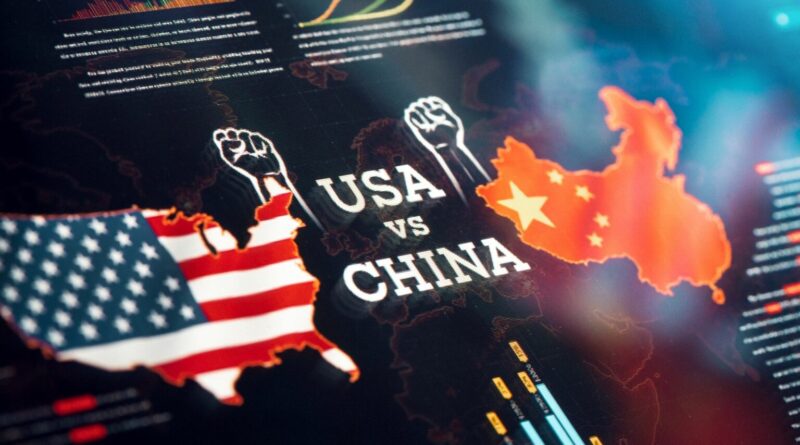China vs USA: The Impact of the Global Trade War
Introduction
The United States and China are the two biggest economies in the world. For many years, they have traded goods and worked together in business. China makes and sells a huge amount of products, while the USA buys many of them.
But now, things have changed. The two countries are in a trade war, meaning they are putting extra taxes on each other’s goods. This fight has affected the world economy, prices, jobs, and even technology.
Let’s understand what this trade war is, why it started, and how it affects countries, companies, and ordinary people.
What Is a Trade War?
A trade war happens when two or more countries put high taxes (called tariffs) on each other’s imports. They do this to protect their own industries and reduce competition from foreign products.
In this case, the United States started adding big tariffs on Chinese goods around 2018. China replied by adding tariffs on American goods. Since then, both countries have been taking turns increasing taxes and restrictions.
Why Did the China–US Trade War Start?
There are several reasons behind this conflict:
1. Trade Imbalance
-
The USA buys much more from China than it sells to China.
-
This difference is called a trade deficit.
-
The US government believes China gains more money from this trade relationship.
2. Technology and Intellectual Property
-
The USA says China copies American technology and forces US companies to share trade secrets.
-
The US wants stronger protection for its technology and inventions.
3. Manufacturing and Jobs
-
Many American factories moved to China because labor there is cheaper.
-
This caused job losses in the US.
-
The US wants to bring back more production inside its own borders.
4. Global Power
-
Both countries want to be world leaders — not just in business, but in military, technology, and politics.
-
This competition adds more tension between them.
How the Trade War Works
When the US adds tariffs on Chinese goods, those goods become more expensive in America.
Similarly, when China adds tariffs on US goods, American products cost more in China.
As a result:
-
People pay higher prices for many products.
-
Companies lose customers or profit.
-
Some businesses move factories to other countries to avoid taxes.
The Effect on China and the USA
Impact on China
-
Some Chinese factories lost big orders from the US.
-
Exporters had to find new markets in Asia, Africa, and Europe.
-
The government started supporting local industries and encouraging people to buy “Made in China” products.
Impact on the USA
-
American companies that rely on Chinese materials had to pay more.
-
Farmers who used to sell soybeans and other goods to China lost income.
-
Prices for everyday goods — phones, clothes, and furniture — increased for US consumers.
The Global Impact of the Trade War
The trade war between these two giants has affected the entire world.
1. Higher Prices Everywhere
When tariffs rise, production costs increase. Many countries buy and sell goods that pass through both China and the US. So, when their prices go up, it affects everyone.
2. Supply Chain Problems
Before the trade war, companies made parts in many countries and assembled them in China.
Now, they are moving factories to Vietnam, India, Mexico, and Indonesia to reduce risks.
This process is called supply chain diversification — but it takes time and money.
3. Slower Global Growth
When the world’s two biggest economies are in conflict, international trade slows down.
-
Businesses invest less because of uncertainty.
-
Global GDP (the measure of total economic activity) grows at a slower rate.
4. Unstable Currency Values
As trade drops, the value of currencies like the Chinese yuan and US dollar keeps changing.
This affects import and export prices all over the world.
Impact on Developing Countries
The trade war has mixed effects on developing nations.
Winners
-
Countries like Vietnam, India, and Mexico gained new investments.
-
Many companies moved their factories from China to these countries.
-
This created new jobs and income for local workers.
Losers
-
Some nations that rely heavily on China’s trade, like Malaysia and Thailand, saw slower exports.
-
African countries that depend on Chinese investments also faced challenges.
The Role of Technology in the Trade War
Technology is one of the biggest reasons behind this trade fight.
1. Control Over Innovation
The US wants to stay ahead in areas like Artificial Intelligence (AI), 5G networks, and semiconductors (chips).
China, on the other hand, is investing heavily to become self-reliant and not depend on American technology.
2. The Huawei Ban
The US government restricted Chinese tech companies like Huawei, saying they could threaten national security.
This ban pushed China to build its own systems and technology instead of using American ones.
3. A Divided Tech World
Because of this, the global tech industry may split into two groups —
-
One using US-based technology (like Apple, Google, Microsoft).
-
One using Chinese-based systems (like Huawei, Alibaba, Tencent).
This separation may limit cooperation and raise costs for everyone.
The Human Side: How It Affects Ordinary People
The trade war doesn’t just affect companies or governments — it affects everyday life.
-
Higher costs: Laptops, phones, and clothes may cost more in stores.
-
Job insecurity: Workers in export industries may lose jobs.
-
Less choice: Some brands or products disappear from markets due to high tariffs.
At the same time, both countries are encouraging people to support local industries — which could help small and local businesses grow in the long run.
Can the Trade War End?
Ending the trade war is not easy. Both countries have deep economic connections but strong competition.
Reasons for Hope
-
Both nations know that cooperation benefits everyone.
-
Talks between leaders continue to reduce tension.
-
Some tariffs may be lowered step by step.
Reasons for Ongoing Conflict
-
The fight is not only about trade — it’s about technology, global power, and future control.
-
Both sides want to lead in innovation and industry.
So, while peace may come slowly, small agreements can help reduce damage to the global economy.
Lessons for the World
This trade war teaches the world some important lessons:
-
No country can work alone.
Every economy depends on others for raw materials, technology, and trade. -
Diversifying trade is smart.
Companies and countries should not depend on just one partner for business. -
Technology is the new battlefield.
Future economic power will come from innovation, not only production. -
Cooperation is better than competition.
When countries work together, everyone benefits — with more jobs, lower prices, and stable growth.
The Future of Global Trade
The trade war is changing how global trade works.
-
Countries are signing regional trade agreements like RCEP (Asia) or USMCA (North America).
-
Businesses are focusing on green energy, digital trade, and automation.
-
Consumers are becoming more aware of where their products come from.
In the next few years, we may see a more balanced trade system, where production is spread across many countries instead of being focused in one place.
Conclusion
The China–US trade war has reshaped the global economy. What began as a fight over tariffs has turned into a long-term struggle over technology, power, and influence.
The effects are clear:
-
Prices for goods have increased.
-
Global supply chains have changed.
-
Many countries have gained new business, while others have lost it.
Even though this trade war brings challenges, it also creates new opportunities for innovation and growth. The world is slowly moving toward a future where trade will be more balanced, industries more diverse, and countries more self-reliant.
In the end, the lesson is simple: The world works best when nations cooperate, not when they compete.

